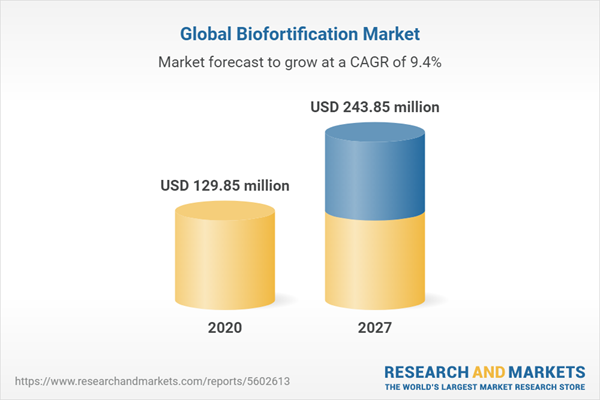Increasing demand for high-nutrition food
The Biofortification market is being driven by factors such as rising demand for high-nutrition food and soaring consumer health consciousness owing to health issues, including occurrences of nutritional deficiencies and malnutrition. According to Forbes, By 2050, the world's population is expected to reach 9.7 million people, requiring a 70 percent increase in global food production in the next 30 years to feed everyone. The global biofortification market is benefiting from rising technological improvements as well as higher investments in agricultural growth. The demand for biofortification is predicted to rise in response to the increasing rates of nutritional deficiencies and the number of children suffering from malnutrition. As a result of surging demand, the worldwide biofortification market is predicted to increase in the projected period.
Lack of knowledge about biofortification
However, a lack of knowledge regarding the advantages of biofortified crops is expected to stifle the biofortification market's expansion. Numerous restrictions put on the production of genetically modified crops have the potential to impede the biofortification market's growth. Trait diversity in the primary, secondary, or tertiary gene pools of the chosen crop is required for biofortification which limits the diversity.
Key Developments
The Philippines announced that it would formally legalize the commercial cultivation of golden rice, which is genetically modified to synthesize beta-carotene, in July 2021. Fedearroz BioZn035, Colombia's first biofortified zinc rice, was launched in October 2021. Owing to many health benefits, it is projected to generate considerable demand in rural areas. HarvestPlus announced on the Intake website in November 2020 that the CSDietary software would be available. Intake is a pioneer in using dietary data to establish evidence-based policies and programs to solve global nutrition concerns.
By crop supply, the biofortification market can be segmented into sweet potato, corn, wheat, cassava, rice, beans, pearl millet, and others.
The sweet potato category accounts for a significant market share owing to expanding technical breakthroughs to boost nutritive value. The demand for biofortified crops such as orange-fleshed sweet potato and cassava has surged due to the requirement of the high carbohydrate content in the human diet.
By nutrient type, the biofortification market can be segmented into iron, amino acids, zinc, vitamins, and others.
Iron and vitamin segments are expected to have sizable market shares. Vitamins are utilized in the animal nutrition business as feed supplements and additives. The increased demand for good quality meat contributes to the rising demand for the vitamin segment.
By technique, the biofortification market can be segmented into Biotechnology, Conventional crop breeding techniques, and Agronomy.
Agronomy comprises applying minerals like zinc or iron as foliar or soil applications based on plant management and characteristics and soil variables to increase the number of critical micronutrients in the plants.By geography, the biofortification market can be segmented into the Asia Pacific, North America, the Middle East and Africa, South America, and Europe. T
he biofortification market is dominated by the Asia Pacific region owing to the transformation of agriculture and improved nutritional value of food in the region. Agrarian countries such as China and India have expanded the potential for the biofortification market substantially. North America is also expected to grow rapidly in the projected period.COVID-19 Insights
The COVID-19 epidemic impacted the biofortification market significantly. The global epidemic has created difficulties like indirect consequences on soil quality, including detrimental effects on soil nutritive balances. Food production has become a significant concern as food poverty is rising worldwide. This has several consequences, including restrictions on the movement of goods and persons between and within countries, as well as market access, particularly in the agricultural sector. COVID-19 may result in a drop in global food consumption and a significant loss of markets and jobs.
Market Segmentation:
By Crop Supply
- Sweet Potato
- Cassava
- Rice
- Corn
- Wheat
- Bean
- Pearl Millet
- Others
By Nutrient Type
- Zinc
- Iron
- Vitamins
- Amino acids
- Others
By Technique
- Conventional plant breeding
- Agronomy
- Biotechnology
By Geography
- North America
- USA
- Canada
- Mexico
- South America
- Brazil
- Argentina
- Others
- Europe
- United Kingdom
- Germany
- France
- Italy
- Others
- Middle East and Africa
- Saudi Arabia
- Israel
- Others
- Asia Pacific
- China
- Japan
- India
- South Korea
- Indonesia
- Thailand
- Taiwan
- Others
Table of Contents
Companies Mentioned
- Syngenta AG
- The Mauro Seed Company
- HarvestPlus
- DowDuPont.
- LemnaTec GMBH
- Bayer AG
- BASF SE
- Corteva agriscience
- Charles River
- ArborGen Inc.
Table Information
| Report Attribute | Details |
|---|---|
| No. of Pages | 115 |
| Published | April 2022 |
| Forecast Period | 2020 - 2027 |
| Estimated Market Value ( USD | $ 129.85 million |
| Forecasted Market Value ( USD | $ 243.85 million |
| Compound Annual Growth Rate | 9.4% |
| Regions Covered | Global |
| No. of Companies Mentioned | 10 |









